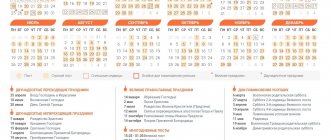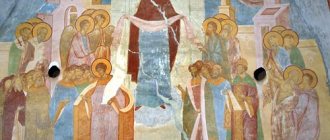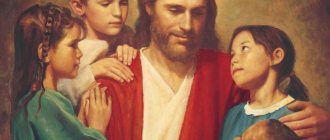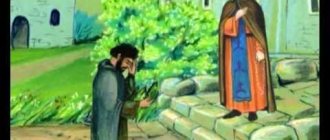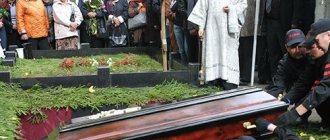The Sunday following Easter is called the Assurance of St. Thomas or Antipascha. In 2021, this holiday falls on May 9.
Despite its name, this day is not opposed to Easter, but rather represents its repetition. According to Holy Scripture, Jesus appeared to his disciples on the very day of his Resurrection, confirming the news about him that the angel conveyed to the myrrh-bearing women at his empty tomb. Eight days later he came to them again, which is celebrated by the holiday of Antipascha. The week between Easter and St. Thomas Sunday is called Bright Week and for believers it is all festive.
Fomina week. Event and history
The service of the first post-Easter week is dedicated to the remembrance of the appearance of Christ the Savior to the holy apostles on the eighth day after His Resurrection. Thomas (translated from Hebrew as “twin”), originally from the Galilean city of Paneas, was chosen by Jesus Christ as one of the twelve apostles, as the evangelists Matthew, Mark and Luke tell us (Matthew 10:2-4, Mark 3 :14-19, Luke 6:13-16). John the Theologian reports the participation of the ap. Thomas in several events of the gospel history, including the assurance of Thomas. On the very day of the Resurrection of Christ, in the evening, all the apostles, except Thomas, were together, and the doors were locked. Suddenly Jesus Christ appeared to them and greeted them with the words: “Peace be with you!” The students were scared, thinking it was a ghost. But He said to them: “Why are you embarrassed? This is I Myself,” and at the same time showed them My hands and feet and ribs. The disciples rejoiced that they saw the Lord. Then He breathed on them and said: “Receive the Holy Spirit. The sins of whom you forgive will be forgiven, and those whose sins you retain will be retained.” When Thomas arrived, the other disciples said to him: “We have seen the Lord.” But Thomas answered them that he would not believe until he himself saw and touched the wounds on the Body of the Lord (John 20:25). Eight days later the disciples were together again and Thomas was with them. The doors were locked. Jesus Christ appeared to them and said: “Peace be with you!” Then, turning to Thomas, he added: “Put your finger here and look at My hands, reach out your hand and place it in My side, and do not be an unbeliever, but a believer.” Thomas exclaimed: “My Lord and my God!” (John 20:28), accurately confessing, in the same way as Bl. writes. Theophylact of Bulgaria, The Divine and Human Nature of Christ the Savior. And Jesus Christ said to him: “You believed because you saw Me, but blessed are those who have not seen and believed!” The Lord, condescending to human weakness, appeared again to allow the unbelieving apostle to sensually verify the truth of the great event that had taken place: for He was resurrected in the same flesh in which He suffered on the cross.
The Gospel narrative leaves it unclear whether Thomas actually put his finger into Christ’s wounds or not. According to some theologians, Thomas refused to do this, while others believe that Thomas touched the wounds of Christ. According to legend, St. From birth, Thomas had two middle fingers fused together, but as soon as he was honored to place them in the side of the Lord, they immediately assumed their normal position. The plot of Thomas's assurance has become a popular subject in gospel iconography. The expression “Doubting Thomas” has become a common noun and means an incredulous person.
Apostle Thomas. Biography and sermon
Based on the story of the appearance of Jesus Christ to the apostles on the Sea of Galilee (John 21:2), we can assume that the Apostle Thomas was originally a fisherman. In the apocryphal “Acts of Thomas”, on behalf of the Apostle Thomas himself, it is stated that his craft is carpentry and construction.
In the Slavic life of St. The Apostle Thomas mentions many miracles that he performed to reassure the pagans. So, wanting to convert the Indian king Gundafor himself to the true faith, he introduced himself as a skilled architect and the king, trusting his words, handed him a lot of gold and precious jewelry to build the most exquisite chamber. But Thomas spent all these funds on the needs of the poor and wretched and, as if to build a roof, asked for more gold, which he spent in the same way. When his case was revealed in its true light, Gundafor was filled with fierce rage and imprisoned St. apostle into a deep ditch. By the Providence of God, at this very time the king’s beloved brother fell into a mortal illness. Then the angel of the Lord delighted his soul, and he saw a wonderful chamber in paradise, but when he wanted to enter it, the angel replied that it belonged to his brother, Gundafor. Thus, according to his brother’s story, the king himself understood that the apostle had done him true good and, having received holy baptism together with his brother, he honorably released him to preach in other villages.
Another miraculous event associated with the Apostle Thomas is recorded in the “Sermon of Epiphanius the Monk on the Life of the Mother of God.” Yes, St. Thomas, who was not among the other disciples on the first day of the Resurrection of Christ, was similarly not present at the Dormition and burial of the Most Holy Theotokos, but appeared in Jerusalem only on the third day after the significant event took place. The holy apostles began to reproach him, reminding him of his previous omission:
When our Lord Jesus Christ rose three days from the grave and appeared to His disciples, you were not with us, and again appeared the second time in the temple, and after 8 days (He) assured you. And now, during the repose of the Most Holy Theotokos, where were you?” He said: “When I was caught up in the clouds, I saw the Holy Mother of God coming into the gates of heaven with the face of an angel, and she gave me Her belt (Face Chronicle).
For the conversion of the son and wife of the ruler of the Indian city of Meliapora (Melipura) to Christ, the Apostle Thomas was imprisoned, endured torture and, pierced with five spears, went to the Lord. It is believed that ap. Thomas suffered martyrdom either in 68 or 72. Ancient church writers report on the preaching of the Apostle Thomas in India, including Gregory the Theologian (329-390), Ambrose of Milan (333-397), Jerome of Stridon (342-420), Paulinus of Nolan (354-431). .) and others. According to Church Tradition, Saint Thomas the Apostle founded Christian Churches in Palestine, Mesopotamia, Parthia, Ethiopia and India.
Veneration of St. Apostle Thomas
In Orthodoxy, the name of Thomas is the eighth day after Easter, which falls on Sunday - Thomas Week . In church usage, St. Thomas week is also called Antipascha , since it falls on the first Sunday after the Great Day. Literally “Antipascha” comes from the Greek. “ἀντι” - “instead”, i.e. "opposite" Easter. The first mention of Antipascha is contained in the “Apostolic Constitutions” of Antiochian origin (about 380), and the description of the Jerusalem service on this day is in the “Pilgrimage of Egeria” (about 400). In the ancient Church, the most numerous baptisms of neophytes were customary to take place on Holy Saturday; for the first eight days after, the newly baptized wore white robes and took them off on the eighth day, that is, on Antipascha.
Memory of St. St. Thomas the Apostle is also celebrated on October 19 (6th Art. Art.), July 13 (June 30 Art.) - Council of the Twelve Apostles. In honor of Ap. Thomas named the island of Sao Tome and the capital of the state of Sao Tome and Principe, the city of Sao Tome. The so-called “Gospel of Thomas,” a Gnostic apocrypha, bears the name of Thomas.
The most ancient evidence of the burial of the Apostle Thomas is found in Ephraim the Syrian. Another is in the apocrypha, which reports the preaching and martyrdom of the Apostle Thomas in northwestern India. About visiting the tomb of St. Thomas was written by many travelers in the 13th-14th centuries. In 1293, Marco Polo (1254-1324) visited India. In his notes, he reports a visit to the tomb of the Apostle Thomas in India, in the Malabar region, and calls the local residents “Christians of the Apostle Thomas.” At the same time, the famous missionary and explorer Giovanni of Montecorvino (1246-1328) will also report on his visit to the tomb of St. Thomas the Apostle in India. And a little later, in 1324, the Franciscan monk Odorico (c. 1274-1331) from Pordenone will write about his journey and worship of the Apostle Thomas at his burial place.
The relics of St. Thomas the Apostle remained in India until the 4th century. Later they found their way to Edessa, then to the Greek island of Chios, and later to Italy, to Ortona, where the remains have been kept from September 6, 1258 to the present day in the Basilica of St. Thomas. But even after the transfer of the saint’s relics, the place of his burial in India was revered as holy. In the Anglo-Saxon Chronicle, when describing the events of 885, King Alfred is mentioned, making a vow in the event of victory to make rich donations to distant sanctuaries, including St. Thomas the Apostle in India. Many documents about the location of the tomb of the Apostle Thomas speak of Melipura (Malai-puram), which translated means “city on the mountain.” But starting from the 7th century, documents mention the city of Kalamine. Here is what Saint Isidore of Seville wrote about this (636): “In fact, pierced by a spear, he (the Apostle Thomas) died in the city of Calamine, in India, and was buried there with honors 12 days before the Kalends of January (21 December)". The Latin prayer books of that time mentioned the city of Kalamine as the place in India where the Apostle Thomas suffered torture and was buried. When the Portuguese found the city of Calamine in 1517, most of its ancient ruins had already sunk under water. Nevertheless, local residents pointed to a place that they called “the tomb of the Apostle Thomas.” It was a small rectangular church with chapels, very ancient and already destroyed, in which there were no images, only crosses. In addition to Ortona, parts of the relics of St. Thomas the Apostle are found in India, Hungary and Mount Athos.
Ritual of the week after Easter
The very heart of the Christian calendar, its central place is, of course, Easter. Since many Christian holidays are moving (that is, they do not have an exact date), few people know or simply forget which holidays come immediately after it. The first week begins on Sunday and is called Bright Week.
Not only weekends, but all weekdays are filled with extraordinary joy for believers, when even two weekly days of fasting - Wednesday and Friday - are canceled.
Fomina week. Divine service
The statutory service of the week of St. Thomas (Antipascha) is performed according to the Tsvetnaya Triodion and corresponds to the rite of the Twelfth Feasts of the Lord, when octaic chants are omitted. The texts of the service are dedicated both to the event of the Resurrection of Christ itself and to St. to the Apostle Thomas. An important theme of the holiday is also the renewal of the whole world by the Cross and Resurrection of Christ. In Christian theology, Sunday is both the first day of the week - the day of the beginning of God's creation, described in the Book of Genesis, and at the same time the eighth, that is, it serves as a prototype of the coming endless age, in which there will be no more time. In this sense, the week of Antipascha has special significance.
The first wretched update of this week, which is truly said to be the wretched one, is also the first. The first, as the beginning of others, osmosising the packs, as if in an image, is being carried out on this endless day, and in the next century. Whoever will be first and alone will not be cut into pieces every night (Sinoksar).
Troparion:
Znamenanu gr0bu, zhi0t, t coffin risen є3сi2 xrte b9e. and with the doors closed, the sun appears, and the sun rises for all. The right ones have updated us, the lord of your mercy.
Kontakion:
With the curious right hand, life-giving of your ribs, fwmA and 3experienced є4st xrte b9e. with the door closed at the bottom, with 8 other posts above, where 3с2 и3 м0й.
Library of the Russian Faith Canon for the Week on Thomas →
Read online
The meaning of Antipascha
The main thing is that the Antipascha faith
is of great importance for all Orthodox Christians:
- the appearance of Jesus to the apostles confirms faith in the truth of the Resurrection of Christ and recalls the covenant of the Savior Himself: “blessed are those who have not seen and yet have believed”;
- the biblical concept of “faith” corresponds to the concepts of “firmness”, “loyalty”, “trust”, and not just recognition of the existence of God;
- Antipascha - the eighth day after the Resurrection of Christ, is a prototype of the coming Kingdom of God, the first day of the renewed world.
Gregory the Theologian drew a parallel between the New Week (Antipascha) and the spring renewal of nature: “Now is earthly spring, spiritual spring, spring for souls, spring for bodies, visible spring, invisible spring; Oh, that we would take part in it there, having been wonderfully changed here, and renewed, crossed over to newness of life in Christ Jesus our Lord!”
Confidence of the Apostle Thomas. Icons
The plot of Thomas’s assurance appears already in the early Christian period (no earlier than the third quarter of the 4th century), which is associated with the development of the passion cycle at the turn of the 4th and 5th centuries. The most ancient images are found on Christian sarcophagi. Among the early monuments, one should also note the Milanese diptych of the 5th century, the mosaic of the central nave of the Church of St. Apollinarius New in Ravenna (6th century).
Over time, a composition was established in Byzantine monuments in which the dialogue between Christ and Thomas is in the very center of the composition, and Thomas’s gesture is concrete, he touches the body of Christ, but does not put his fingers into the wounds. The apostles part so that evidence of the Resurrection can be seen (mosaics of Daphne and Hosios Loukas of the 11th century).
The theme of Thomas's assurance is found in Rus' in the frescoes of the St. Sophia Cathedral in Kyiv of the 11th century, as well as in the painting of the Transfiguration Cathedral of the Mirozhsky Monastery in Pskov. The iconography of “Assurance of Thomas” was not only part of the cycle of many monumental paintings, but it was often depicted on lectern icons. At the turn of the 15th-16th centuries, the scene “Assurance of Thomas” was included in the festive row of the iconostasis of the Kirillo-Belozersky Monastery and the Trinity Cathedral of the Pavlo-Obnorsky Monastery.
Thomas's assurance. St. Sophia Cathedral, Kyiv, Ukraine. Fresco of the lower register of the southern part of the transept
Thomas's assurance. Sergiev Posad Museum-Reserve. XV century
Thomas's assurance. Double-sided tablet icon. End of the 15th - beginning of the 16th centuries. Novgorod State historical, architectural and art museum-reserve
The icon “Assurance of Thomas” (Dionysius and his workshop) from the early 16th century is widely known. In accordance with the gospel narrative, Jesus Christ is depicted in the center of the composition against the background of closed doors. On both sides of Him are the apostles, who have already been rewarded with a vision of the risen Savior; in the foreground on the left is the Apostle Thomas, extending his right hand to the Savior and touching His ribs. The figure of Thomas is highlighted in the composition with a bright cinnabar cloak, contrasting with the restrained in tone clothes of the others depicted. The thin, elongated figure of the Savior is correlated with the doorway behind His back, which allows us to recall the words of Christ: “I am the door: by me whoever enters will be saved.”
Thomas's assurance. Dionysius and the workshop. Beginning of the 16th century
Saint Thomas the Apostle is often shown in icons as a young man, without a mustache or beard. The red background of the icon is evidence of martyrdom. In another version (it is not so widespread), the Apostle Thomas is depicted as an old man - this iconographic plot is dedicated to the service of the apostle in India.
According to tradition, the Apostle Thomas is depicted in the attire characteristic of that time - a chiton (a type of long shirt) and a himation (outer clothing in the form of a rectangular piece of fabric). The colors of the clothes in which the Apostle Thomas is traditionally written are as follows: chiton - dark green or blue, himation - red. The right hand of the Apostle Thomas is raised in a blessing gesture, the left (depending on the tradition) is either hidden under the himation, or holds a scroll (codex) - this is a symbol of the Gospel, the Good News that Saint Thomas brought to the peoples of Palestine, India and Ethiopia.
Thomas's assurance. Paintings
The plot of Thomas' Assurance became widespread in Western European art, in the works of Duccio di Buoninsegna, Guercino, Caravaggio, Rembrandt, Rubens and others.
Thomas's assurance. Caravaggio. XVII century
The Unbelief of Saint Thomas. Guercino. Pinakothek. Vatican
Thomas's assurance. Peter Paul Rubens
Temples in honor of the Assurance of Thomas
In honor of the Assurance of Thomas in the Resurrection of Christ, the church on Myachina in Veliky Novgorod . The temple was built in 1463. Once upon a time there was a Resurrection Monastery here. Only the foundations remain of the original Church of the Assurance of Thomas, built in 1195-1196. The old church collapsed due to disrepair, and in 1463 a new one was built on the same foundations in the style of 12th-century architecture. The church is currently inactive.
Church of the Assurance of Thomas in the Resurrection of Christ on Myachina in Veliky Novgorod
Active Old Believer churches in honor of St. Apostle Thomas is not available at present.
What else can you do?
In addition, on Fomino Sunday, believers usually attend church services and go to cemeteries to remember the dead with their prayers. This year, not everyone will decide to take such actions, wanting to protect the health of themselves and their loved ones. The coronavirus pandemic has changed a lot in people's lives. However, no one bothers you to pray in front of the icons, having first washed yourself with holy water, left overnight in front of the images.
From the very morning, believers also prepare various treats and choose beautiful outfits. According to legends, it is also necessary to feed seven animals. In this case, money will not stop being transferred in the house, and luck will not bypass the family.
Red hill. Folk traditions
“ Red Hill ” is a purely folk tradition in the name of the holiday. Spring is already coming into its own at this time, but the snow always begins to melt from the hills, which are the first to be decorated with young greenery and flowers. “Red” means “beautiful”, “beautiful”: when going on a walk on this day, the villagers often chose the hill that they liked most, hence the corresponding name for the day.
Red Hill in the popular understanding is the most suitable time for marriage. Starting from St. Thomas Sunday, after a long Lenten break, the sacrament of weddings is resumed. Russian proverbs said: “On Krasnaya Gorka there is a showdown of girls”; “Let’s count each other in the spring on the logs - on the Red Merry Hill, let’s count, let’s count, we’ll be married with a golden crown.” In Rus', it was on this day, Fomino Sunday, that the largest number of weddings took place; festivities, round dances, and matchmaking were held. Everywhere girls walked the streets and sang stoneflies. Krasnaya Gorka was one of the most beloved holidays in pre-revolutionary Russia.
M. Boskin. "Round Dance", 1910
In the Upper Volga region, Eve (Saturday) or Fomino Sunday was called “Vyunishnik” or “Klikunishno Sunday”, because on this day, after the service, village youth in droves approached the houses where the young spouses lived, married in the past meat-eater, and shouted : “Young, young, give me a vine (young), and if you don’t give me a vine, you’ll be an anemone.” They shouted until the window in the hut opened and the young woman served colored eggs and pies. In some regions, married men and women joined the youth and also shouted: “Loach and loach, give me a kokurk and an egg; if you don’t give it, we’ll break into the porch.” Kokurka is a large, round, wheat pie with raisins: it was baked by those women who had been married for the first year, and was intended for girl friends, to whom it was handed with low bows and with a silent request that the girls take their young people out for walks. , recently married women. The girl who accepted the loaf from the hands of the young woman gave a third of this loaf to the young, the other third to the men, old women and children, and the rest was taken into the house and eaten by the girls while singing songs.
How to celebrate Antipascha
The services of St. Thomas Sunday, according to the Jerusalem Charter, are performed according to the rite of the Twelve Feasts of the Lord, although formally this day does not belong to them. There is a custom to celebrate the last day of Bright Week as the “second Easter”, to make Christ and give each other colored eggs. True, in contrast to the traditional red color, for Anti-Easter they are painted in funeral colors - yellow and green. This was due to the fact that Antipascha was superimposed in the popular consciousness on the ancient spring rites of the revival of nature and the triumph of life over death, when the dead were remembered. They said that on Fomino Sunday “baptized people share Christ with the dead.”
On this day, for the first time since the beginning of Lent, churches began to hold weddings, opening the spring wedding season. Getting married on Fomino Sunday itself, which was also called “Red Hill” in honor of the festivities and round dances on dry high places, was considered the key to a happy married life. There was a saying: “on Maslenitsa there is matchmaking, on Krasnaya Gorka there is a wedding.” As well as commemorating the dead, weddings and honoring the newlyweds during this period were also a tribute to paganism: in the spring, when life triumphs and is reborn, defeating cold and death, one must express respect for ancestors and enter into marriages that will lead to the birth of children.
Radonitsa. Folk traditions
Tuesday of St. Thomas Week is called “ Rainbow ” or “ Radonitsa ”. On this day, Orthodox Rus' usually remembers its relatives. The day before, peasant women baked pies, wheat pancakes, pancakes, kokurki, prepared wheat and noodle cakes, cooked meat, jelly and fried eggs. With all these dishes they went to the churchyard, where the priest came with the clergy to serve a requiem service at the graves. During the funeral services, the women, gathered in groups of five, treated the clergy to pies, jelly and porridge. Since during the service women began to cry loudly, with lamentations and howls, men tried not to attend such funeral services so as not to see women’s tears. The clergy, having tasted the treats, went home. And after that, men came to the graveyard and began a feast at the graves. The peasants said Christ to their dead relatives, remembered them, buried colored eggs in their graves, poured mash on them, covered them with fresh turf, on top of which they placed various tasty dishes.
F.S. Shurpin. Sketch for the painting “Radonitsa”. Second half of the twentieth century.
When the dishes were placed, the peasants called out the afterlife guests by name and asked them to drink and eat at the funeral meal. But while treating the dead, the peasants did not forget themselves, so that by the end of the memorial there were usually a lot of drunks in the cemetery. The same thing happened in city cemeteries, where on the day of “Rainbow”, reinforced police units arrived to suppress outrages.
What not to do at a funeral
Almost all dead people need our prayers. Moreover, they need this every day, and not just on holidays and after Easter, because the mention of the departed is as integral a part of the daily prayer rule as the “Our Father.”
But folk customs diverge quite strongly from church customs, so it is worth mentioning what is strictly forbidden to arrange in a cemetery and at home funerals and is not approved by the church:
- Drinking strong alcoholic drinks (vodka, cognac, tinctures).
- Intemperance in everything (in fun, in food, in wine, in verbiage).
- Leaving food and drink on graves is a relic of paganism.
- Cry loudly and lament for the dead.
- Prayers for suicides must also be coordinated with a priest.
Instead, it is better to distribute the remaining food and alms to those in need; in general, you need to act in a Christian way. If we all simply become more humane, forgive our enemies, learn to support each other in grief, not argue or quarrel, then this will be much more help to our ancestors than any feasts and loud sobs at the grave.
Fact!
It is especially important to do good deeds in memory of suicides, who are often refused to have funeral services or mentioned at services. It is forbidden to light candles for them and leave any offerings in the temple, although voluntary prayer at home for those who have passed away is, of course, permitted.
In any case, this issue is resolved individually with the ruling bishop of the Diocese. You will need to have all the necessary certificates with you to prove the possibility of an accident, for example, about the presence of a mental illness at that time.
Although the Church is very understanding of the fact that not every person is so deeply in the Church as to even simply acquire an Orthodox Prayer Book. Many only occasionally attend divine services, do not participate in the sacraments, and practically do not know the canons.
Therefore, hesitant people often want to turn to God in their own words, so that prayer becomes more alive and sincere. And yet, it is recommended that already at the beginning of the path of churching one should rely on established prayer rules that will help every infant soul. After all, someone who has not yet become spiritually strong, how does he know how and how much to pray?
Soulful teaching on St. Thomas' week
About the spiritual understanding of the holiday of Antipascha, as “the day of renewal of the Resurrection of Christ,” we read a detailed explanation in the instructive word of St. Gregory the Theologian:
"What? - you say. “Wasn’t the day of renewal and the first Sunday that followed this sacred and luminous night?” Why do you give this name to this day, O idle lover, who invents many fun things?” “That was the day of salvation, and this is the day of remembrance of salvation.” That day demarcates burial and resurrection, but this one is purely the day of new birth, so that just as the first creation begins as a weekday (and this is evident from the fact that the seventh day from it is made Saturday, because it is a day of rest from work), so too the second creation began again on the same day; because he is the first among those who follow him, and the eighth among those who precede him - a high day, a wondrous day, for it leads to a heavenly state. It seems to me that the divine Solomon is also guessing about this day, commanding to give “a portion of seven,” that is, of present life, and “eight” (Eccl. 11:2), that is, of future life, both from the good deeds here and from those there. recovery. But the great David, in honor of the same day, sings his psalms about the “eighth” (Ps. 6 and Ps. 11), since on the same day of renewal he sings another psalm (29), calling some kind of “renewal of the house,” and this home - we who are worthy to be, be called and become the temple of God (St. Gregory the Theologian, Homily 44).
“Thomas, who was once weaker than the other apostles in the faith,” says St. John Chrysostom regarding the martyrdom of the apostle. Thomas, “by the grace of God he became more courageous, more zealous and tireless than all of them, so that he went around almost the entire earth with his preaching, not being afraid to proclaim the Word of God to the savage peoples.”
What should you not do on this day?
To avoid changes in fate for the worse, you should know what is prohibited to do on this holiday.
- It is not recommended to work, much less dig in the ground. This is a celebration of her rebirth, there is no need to disturb her at such a moment.
- Under no circumstances should you quarrel, since according to signs it will be difficult (impossible) to make peace before Trinity.
- This holiday you shouldn't stay at home alone. You should put on the most beautiful and brightest outfit and go to a crowded place.
- According to the rules, spouses cannot walk or celebrate separately on Krasnaya Gorka. Thus, they could cause discord, quarrels, and separation.
- It is not recommended to talk to someone about the ablution ritual at all. According to legend, this will help the evil eye to cast a curse (evil eye).
Comments
